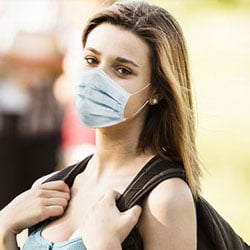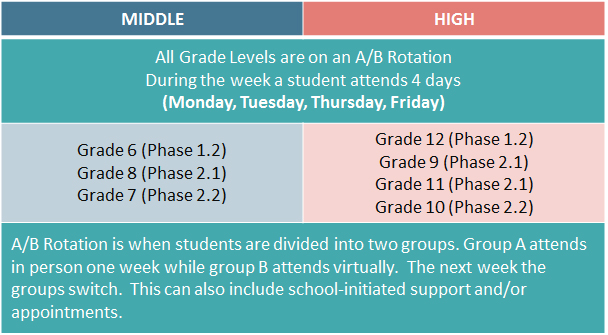 MONTGOMERY COUNTY PUBLIC SCHOOLS
MONTGOMERY COUNTY PUBLIC SCHOOLS
 MONTGOMERY COUNTY PUBLIC SCHOOLS
MONTGOMERY COUNTY PUBLIC SCHOOLS

![]() Important note: In all rotation models WEDNESDAYS REMAIN VIRTUAL-ONLY, except on short weeks where there is a day off. On those short weeks, Wednesdays are instructional days for all middle and high school students.
Important note: In all rotation models WEDNESDAYS REMAIN VIRTUAL-ONLY, except on short weeks where there is a day off. On those short weeks, Wednesdays are instructional days for all middle and high school students.
Schools have determined the number of students they can serve in person and are finalizing their planning and selection of instructional models to implement for these students. Schools will only be able to accommodate a limited number of students in person given space limitations, health and safety guidelines and staff availability. Priority groups for the first phase of return include:
Please note that there may be a combination of instructional models across a students’ day and/or weekly rotational schedule. For example, a secondary student may come into the school for two classes taught in a simultaneous model and then be supervised in a support model to engage in their remaining classes virtually.

Students will remain enrolled in their core academic classes, required courses, electives, support classes and special programs, according to the school-developed master schedule. Students/parents/guardians may request a reduced course load using MCPS Form 280-98, in close consultation with the school counselor and approval by the principal. Students will have until the first week of the second marking period of the semester to withdraw from a course without notation on the academic record (extended from the 25th day of the semester).
Special education services will be provided through a combination of in person and virtual service delivery models depending on the student's Individualized Education Program (IEP).
An important part of the initial return is providing opportunities for in-person experiences in selected career and technical education programs, starting with programs that are more hands-on with specialized labs, tools and equipment, and facilities. These in-person experiences are vital in helping our students, particularly seniors, prepare for industry certification and licensure exams, as well as help them make decisions for their next steps after high school.
In this example, different models could be implemented based on different variables such as how many students prefer in-person, staff availability, and facility capacity. For example, at the automotive or construction programs at Thomas Edison High School of Technology, some students may wish to remain virtual while others prefer in-person experiences. That would be a set up for either the support model or simultaneous instruction, or a blend of the two.
In both of these scenarios, the teacher would teach from their classroom and be able to conduct demonstrations for students both in-person in the classroom and on Zoom. This could be applied to either a Support Model or Simultaneous Instruction, with support from additional school staff.
At designated times, students in-person would access the equipment and apply what they have learned in the hands-on setting, while students at home continue with virtual simulations.
In the support model, the teacher would continue to teach virtually while other staff supervise the in-person, hands-on work. Or vice versa--the certified teacher may need to lead the demonstration on the equipment while other staff engage with students virtually.
In some cases, there may be a class in which 100% of the students wish to come to school for in-person experiences, in a large space such as the automotive lab. Those conditions would lend themselves to the direct teaching model.
In each of these examples, students would attend the rest of their classes virtually, but while in the building and with available staff/technology support.
This example helps illustrate that there is no single approach and the instructional models could vary or be combined for program delivery.

![]() Important note: Day begins at 7:45 am, but first class is at 9 am
Important note: Day begins at 7:45 am, but first class is at 9 am
Proceeds through online learning as we do presently
Students will remain enrolled in their core academic classes, required courses, electives, support classes and special programs, according to the school-developed master schedule. Students/parents/guardians may request a reduced course load using MCPS Form 280-98, in close consultation with the school counselor and approval by the principal.
Students will have until the first week of the fourth marking period to withdraw from a course without notation on the academic record (extended from the 25th day of the semester).
Adjustments will be made to required content, pacing, and assessment in some content areas.
Like a traditional schedule, students will be assigned to their subject area teachers by class period. This includes courses required for graduation, electives, Honors and advanced courses, and special programs such as career and technology education.
Special education services will be provided through a combination of in person and virtual service delivery models depending on the student's Individualized Education Program
MCPS is working closely with the Maryland State Department of Education to ensure students are able to meet all requirements in a virtual-only model. These include programs housed at Thomas Edison High School of Technology and Seneca Valley High School. All students, whether they are at the very beginning of a program or continuing on in a program they had already started, will engage in rigorous and meaningful career-related instruction and have the opportunity to complete their career program. Students will have relevant, real-world experiences through web conferences, virtual simulations, project based learning, capstone projects and more. Students will be provided with the required software and technology for learning. Staff will continue to work on the development of modifications for some of the more equipment intensive programs, such as Automotive, Construction, Cosmetology, and Restaurant Management. These programs will be prioritized in the first phase of in-person return.
The live instructional schedule will include full class periods, with teachers fully engaged with their students for the duration of the lesson.
Generally, students will have four full class periods per day and will also be provided time for additional live academic and/or social-emotional support. Each class will meet at least two times each week.
The non-scheduled class time on Wednesdays is designed to encourage connection and support outside of the daily classes.
The non-scheduled class time will focus on:
At the secondary level there are additional goals for this non-scheduled time including:
During non-scheduled class time, staff will be engaged in activities that directly relate to planning, instruction and assessment. This includes individual and collaborative planning, examining student work, grading or professional development.
We continue to build upon and make improvements to the virtual model to ensure excellence, access and equity in the learning experience. Our virtual learning model will continue to provide engaging and enriching instruction for all students at all grade levels.
All students will continue to have live, teacher-led instruction and a full day of instructional experiences.
MCPS will provide a wide range of supports and resources to help students, staff and families successfully engage in virtual instruction.
Lessons will be recorded for students that cannot access the lesson at the scheduled time.